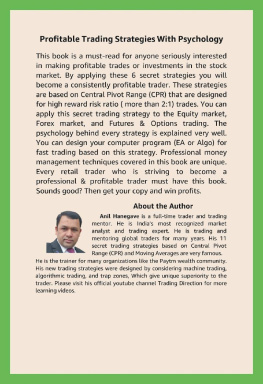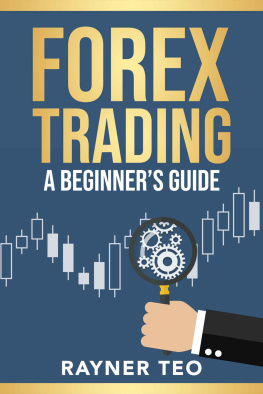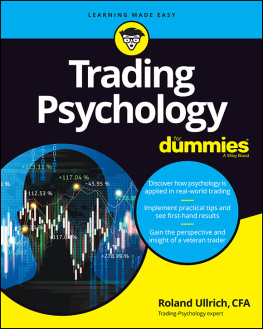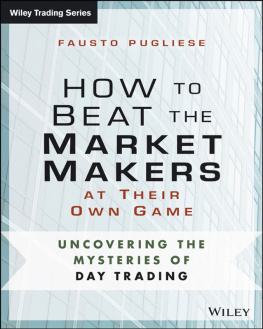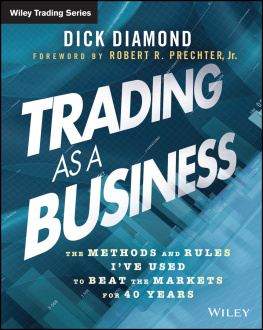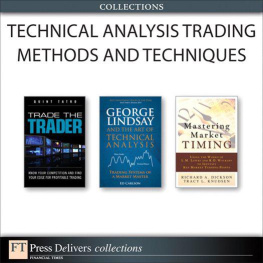PRAISE FOR
E LLIOTT W AVE T ECHNIQUES S IMPLIFIED
On my radio program, Bennett McDowell made a bold, unpopular prediction for the 2008 stock market, saying it could fall dramatically. And, then it happened. What alerted Ben to the upcoming crash was expressed in patterns of market behavior which have reoccurred throughout market history. With this book, Elliott Wave Techniques Simplified, you can learn how Bennett McDowells system can help increase your odds for success, by harnessing the power of probability forecasting.
GABRIEL WISDOM, Host of the Financial Wisdom Radio Program
As always, Ben McDowell does an excellent job of explaining a complicated subject, plus Ben adds a new dimension to the analysis with his Probability Matrixtaking some of the vagueness out of the analysis. Whether or not you rely on Elliott Wave analysis, this book will explain it in such a way that youll be able to decide it if belongs in your arsenal of technical weapons or not.
LAWRENCE G. MCMILLAN, President McMillan Analysis, author of Options as a Strategic Investment
Ive always felt that applying Elliott wave principles could be very helpful in analyzing the market, but felt overwhelmed when I tried to make sense of it. Bennett presents a well written book on both the classic Elliott wave theories and adds some great tips on how to check or confirm your wave counts. This is a great place to start for anyone interested in this methodology.
CAROLYN BORODEN, aka Fibonacci Queen, Author of Fibonacci Trading: How to Master the Time and Price Advantage
I love this book! It provides an excellent understanding of using the Elliott Wave. It goes into the history of Elliott Wave from the founder of Elliott Wave theory, Ralph Nelson Elliott, to Robert Prechter who kept the wave alive. The book also explains how manias, panics, bubbles and crashes work with the five waves using psychology. This book is a must for anyone who believes there is a method of trading using chart patterns in terms of Elliott Wave.
LARRY JACOBS, Editor Traders World Magazine
A Japanese proverb says, If you wish to know the road, inquire of those who have traveled it. My friend Bennett McDowell clearly knows the Elliott Wave road. His book fuses together his years of real world experience with his skills at computerized trading. Elliott Wave Techniques Simplified does exactly what the title says, it truly simplifies the principles of Elliott Wave. For those new to Elliott or those who have been using it for years, this is a resource that you must have.
STEVE NISON, CMT, Founder and CEO of Candlecharts.com and the first to reveal candlesticks to the Western world
Elliott Waves are all about forecasting but to be able to forecast as well as Ralph Nelson Elliott is a challenge. In Elliott Wave Techniques Simplified Bennett McDowell clearly explains how you can combine Elliott Waves with other techniques to identify tops and bottoms in the markets. Readers will be able to eliminate some of the uncertainties of using Elliott Waves and will be more confident in their entries and exits. Applying the methods discussed in this book will sharpen your forecasting skills.
JAYANTHI GOPALAKRISHNAN, Editor Technical Analysis of Stocks & Commodities Magazine
R.N. Elliott developed his wave theory based on harmonious patterns within the laws of nature. Now Bennett McDowell has taken Elliott Wave analysis to a new watermark, sharing his Probability Matrix to provide traders and investors with an objective framework to evaluate any stock or market in detail. Newer traders and market veterans alike will enjoy the many lessons shared by a real-world trader and renowned educator to guide them though the many facets of successful trading.
PRICE HEADLEY, CFA, CMT, Founder of BigTrends.com
Throughout Elliott Wave Techniques Simplified, Bennett is mindful of providing both sound theory and practical applications. While he helps decode the secret language of Elliotticians, he never forgets that it is critically important to understand how to employ Elliott Wave interpretation in todays markets. Having worked closely with Bennett for many yearsand having heard him present his work directly to traders on countless occasionshis passion for his subject and respect for his audience are always apparent. Elliott Wave Techniques Simplified is no exception.
STANLEY DASH, CMT, VP, Applied Technical Analysis, TradeStation Securities
Copyright 2016 by McGraw-Hill Education LLC. All rights reserved. Except as permitted under the United States Copyright Act of 1976, no part of this publication may be reproduced or distributed in any form or by any means, or stored in a data base or retrieval system, without the prior written permission of the publisher.
ISBN: 978-0-07-181931-2
MHID: 0-07-181931-2
The material in this eBook also appears in the print version of this title: ISBN: 978-0-07-181930-5, MHID: 0-07-181930-4.
eBook conversion by codeMantra
Version 1.0
All trademarks are trademarks of their respective owners. Rather than put a trademark symbol after every occurrence of a trademarked name, we use names in an editorial fashion only, and to the benefit of the trademark owner, with no intention of infringement of the trademark. Where such designations appear in this book, they have been printed with initial caps.
McGraw-Hill Education eBooks are available at special quantity discounts to use as premiums and sales promotions or for use in corporate training programs. To contact a representative, please visit the Contact Us page at www.mhprofessional.com.
This publication is designed to provide accurate and authoritative information in regard to the subject matter covered. It is sold with the understanding that neither the author nor the publisher is engaged in rendering legal, accounting, securities trading, or other professional services. If legal advice or other expert assistance is required, the services of a competent professional person should be sought.
From a Declaration of Principles Jointly Adopted by a Committee of the American Bar Association and a Committee of Publishers and Associations
TERMS OF USE
This is a copyrighted work and McGraw-Hill Education and its licensors reserve all rights in and to the work. Use of this work is subject to these terms. Except as permitted under the Copyright Act of 1976 and the right to store and retrieve one copy of the work, you may not decompile, disassemble, reverse engineer, reproduce, modify, create derivative works based upon, transmit, distribute, disseminate, sell, publish or sublicense the work or any part of it without McGraw-Hill Educations prior consent. You may use the work for your own noncommercial and personal use; any other use of the work is strictly prohibited. Your right to use the work may be terminated if you fail to comply with these terms.
THE WORK IS PROVIDED AS IS. McGRAW-HILL EDUCATION AND ITS LICENSORS MAKE NO GUARANTEES OR WARRANTIES AS TO THE ACCURACY, ADEQUACY OR COMPLETENESS OF OR RESULTS TO BE OBTAINED FROM USING THE WORK, INCLUDING ANY INFORMATION THAT CAN BE ACCESSED THROUGH THE WORK VIA HYPERLINK OR OTHERWISE, AND EXPRESSLY DISCLAIM ANY WARRANTY, EXPRESS OR IMPLIED, INCLUDING BUT NOT LIMITED TO IMPLIED WARRANTIES OF MERCHANTABILITY OR FITNESS FOR A PARTICULAR PURPOSE. McGraw-Hill Education and its licensors do not warrant or guarantee that the functions contained in the work will meet your requirements or that its operation will be uninterrupted or error free. Neither McGraw-Hill Education nor its licensors shall be liable to you or anyone else for any inaccuracy, error or omission, regardless of cause, in the work or for any damages resulting therefrom. McGraw-Hill Education has no responsibility for the content of any information accessed through the work. Under no circumstances shall McGraw-Hill Education and/or its licensors be liable for any indirect, incidental, special, punitive, consequential or similar damages that result from the use of or inability to use the work, even if any of them has been advised of the possibility of such damages. This limitation of liability shall apply to any claim or cause whatsoever whether such claim or cause arises in contract, tort or otherwise.


